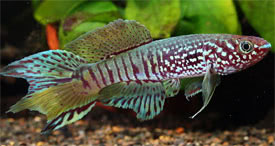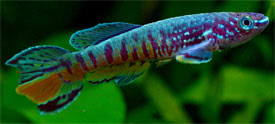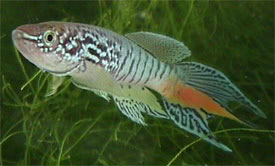
 Magyarul / Hungarian
Magyarul / Hungarian



- Scientific name: Fundulopanchax sjostedti
- Synonyms: Aphyosemion caeruleum, Aphyosemion sjostedti, Aphyosemion zimmeri, Fundulopanchax caeruleus, Fundulopanchax zimmeri, Fundulus caeruleus, Fundulus gularis caerulea, Fundulus sjostedti, Fundulus zimmeri, Blue gularis
- Common name: Golden Pheasant, Red Aphyosemion
- Group: Killifish
- Habitat: Western Africa
- Size: 14 cm
- Biotope: Found in water holes in west Africa from southern Nigeria and the western Cameroons as far as Ghana.
- Social behavior: A lively species that is predatory towards small fish.
- Diet: Carnivorous, will eat only live food; recommended Tubifex, mosquito larvae, adult insects and small fish.
- Breeding: Quite easy
- Tank: Minimum 80 litres
- Population: 1 male and 2-3 females for 80 litres
- Decoration: Needs a roomy tank with 8 to 12 inches of water (20-30 cm). Add a dark tank bottom and lots of vegetation with plenty of hiding places such as roots and stones.
- Temperature: 22-26 °C
- pH: 6-7
- Hardness: 2-12 NK°
- Lifespan: 2 years
Description: An elongated species with a fan-shaped caudal fin. The color depends entirely on the population. Two variants are most often seen; a green and a golden type. The green variant has a base colour of green with overlaying red spots and stripes. The lower parts are blue and the belly is white. The fins are green with red markings and have a green edging. Females are reddish-brown. The golden race has an shiny olive-brown back, and green-gold to blue-gold flanks. The front part of the body is marked with dark red spots, while the rear part has several dark red, transverse stripes. The fins of this morph are green-gold in color and red splotches mark them. Females are brown-gold.
The males are more brightly coloured than females, and males are also being larger. Breeding is possible in a small tank: at least two gallons of water per pair. Add a tank bottom of thick peat since the fish bury their eggs. After spawning press excess moisture from peat and keep it in plastic bags for 4 to 6 weeks at temperatures between 18 and 20 °C. Do not let the peat dry. Be sure to air out the bag periodically. Add soft water to hatch the fry. Feed them with small live food such as Artemia nauplii.




































































